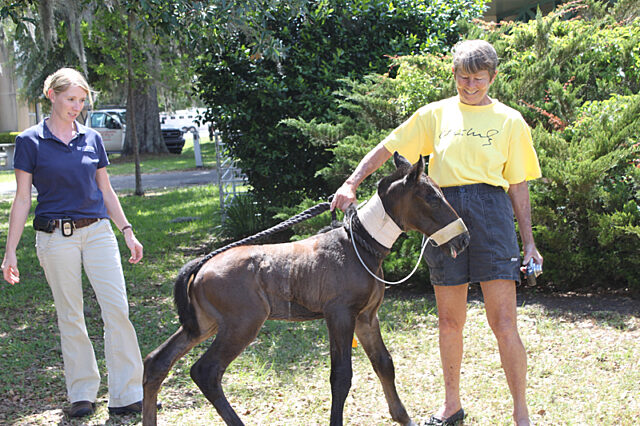UF, Texas A&M collaborate in cloned foal birth

UF equine medicine resident Stephanie Meyer, left, keeps an eye on Mouse, a cloned foal born at UF’s Large Animal Hospital on May 5, while he visits with his owner, Kit Knotts of Cocoa Beach. (Photo by Sarah Carey)
The management of a high-risk pregnant mare and her foal’s subsequent birth might be business as usual at the University of Florida College of Veterinary Medicine, but the case of Minnie and Mouse was anything but routine. That’s because Mouse, a spindly, dark brown Lipizzaner colt cloned from a Florida resident’s beloved stallion, was the first test tube baby delivered at UF.
Nearly six weeks after Mouse’s birth May 5 and a month after his discharge from UF’s Large Animal Hospital, he is a happy, healthy, bucking foal enjoying the good life at his home in Cocoa, Fla.
“There have been several issues with cloned offspring, and while this isn’t the first cloned foal, there are few in the world,” said Margo Macpherson, D.V.M., an equine reproduction specialist and associate professor at UF. “So the fact this baby is alive and is currently thriving is a very good thing.”
Since the technology was pioneered at Texas A&M University’s College of Veterinary Medicine and Biomedical Sciences in 2004, TAMU has produced 14 cloned foals, of which 12 survived and remain healthy, according to an article in the May 1 Journal of the American Veterinary Association.
Technically known as somatic cell nuclear transfer, the cloning process that resulted in Mouse’s birth also took place at Texas A&M. Mouse’s owner, Kit Knotts, a Cocoa Beach, Fla., resident and a longtime client of UF’s Large Animal Hospital, knew that UF was experienced in the management of equine neonatal foals and had the expertise to carry Minnie and Mouse successfully through the latter part of Mouse’s development from nuclear transfer-produced embryo to live horse. Teams from UF’s equine reproduction, medicine and surgery services were all involved in that journey.
Knotts visited Gainesville in mid-March to meet with several members of UF’s reproduction and medicine teams. Two weeks later, Minnie arrived, just shy of 300 days gestation.
Meanwhile, Macpherson and cloning guru Katrin Hinrichs, D.V.M., Ph.D., of Texas A&M, began communicating about Minnie’s care and issues encountered in treating other cloned foals. In addition, Malgorzata Pozor, D.M.V., Ph.D., a reproduction specialist and clinical assistant professor, teamed up internally with Rob MacKay, B.V.Sc., Ph.D., a large animal medicine specialist and professor at UF, and Stephanie Meyer, D.V.M., a third-year large animal medicine resident, to plan the horses’ care.
Although veterinarians worried that Minnie would give birth prematurely, a situation that would have meant almost certain death for the foal, the mare held on to carry Mouse to term.
Mouse, a foal cloned at Texas A & M University and born at UF’s Large Animal Hospital in May, is shown outside the hospital barns about a week after his birth. (Photo by Sarah Carey)
“When we believed the mare was close to foaling, the reproduction, medicine and surgical clinicians communicated regularly,” MacKay said. “Taking into consideration the special needs previously cloned foals have had at the time of birth, a strategic plan was formed early that encompassed all possible supportive therapies and intervention needs that may be required at the time of foaling. This included addressing any unexpected foaling complications for the foal and/or the mare.”
For example, UF veterinarians knew that for unknown reasons, many cloned foals have needed oxygen support at birth, so they planned ahead of time to start administering oxygen therapy immediately after the foal was born.
“Additionally, we knew an IV catheter was going to be required shortly after birth for administration of plasma, as we were aware that the mare’s colostrum quality was poor prior to her going into labor,” Meyer said. Plasma is administered to transfer the parent’s antibodies to build the foal’s immune system.
Mouse’s birth proceeded without incident. Minnie passed her placenta within an hour of foaling, and the foal was sitting up and alert within five minutes – all good signs, veterinarians said. As time progressed, however, Mouse was unable to stand without assistance. At that point, veterinarians administered antibiotic therapy, supportive fluid therapy and regular feedings of the mare’s milk. Within the next few days, additional problems were diagnosed, similar to those seen in premature foals. UF equine surgeons operated on Mouse to remove his umbilical remnants, eliminate a urinary problem and remove a blood clot from his bladder. In about a week, the infections had greatly improved. Knotts was at Mouse’s side throughout his treatment.
“It was a complete pleasure to work with Kit. She was supportive of any therapies, preventative interventions and critical care monitoring recommendations that we felt would not only increase the foal’s chance of survival, but also his optimal health,” Meyer said. “I think this foal helped demonstrate that we are good at what we do. When challenged with new and unusual circumstances, we can have successful outcomes.”
Meanwhile, Knotts could not be happier. After arriving back home, Mouse quickly bonded with Marc, his healthy and sound 30-year-old DNA twin. Knotts has owned Marc, a Dressage champion, for 24 years. It was as a tribute to him — and after a futile nationwide hunt to find another horse she really wanted — that Knotts first embarked upon the odyssey of the cloning process.
She has no regrets. In fact, another surrogate mare pregnant with Marc’s next cloned twin is expected to journey from Texas A&M to UF in mid-August for management by equine specialists.
“I think the whole team approach we have is so outstanding,” Knotts said. “It’s not just the doctors; it’s the students and the nurses, even the stall cleaners. They’re just the most amazing crew I have ever encountered. The team is just top-notch.”
About the author
